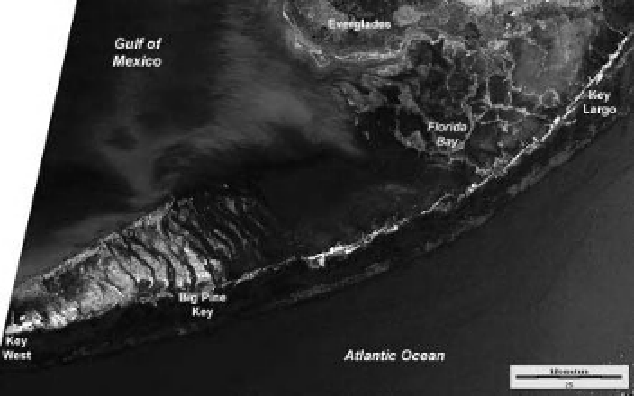Geoscience Reference
In-Depth Information
latitudes (
30° N and S) in clear water with
normal marine salinity (33-36‰) and tempera-
ture of 20-29 °C (United Nations Environmental
Program 2004). About 800 reef-building coral
species (order Scleractinia) live in symbiotic rela-
tionships with algae and may grow at rates up
to 15 cm/year. More than 100 coral-reef com-
plexes exist around the world; most are found
in the Caribbean Sea, Red Sea, Indian Ocean, and
equatorial Pacii c (World Resources Institute
2011). Indonesia has the greatest area of coral
reefs (
<
50,000 km
2
), and the largest single reef
complex is the Great Barrier Reef of Australia
(Fig. 7-7). In the United States, coral reefs are
abundant in islands of Polynesia and Micronesia
-
Hawaii, Guam, etc. The Florida Keys contain
the most extensive coral reef in the coterminous
United States (Fig. 7-8).
Reefs are organically constructed environ-
ments, built on the aragonite (CaCO
3
) founda-
tion secreted by coral polyps as their living
platforms. Coral reef wetlands are among the
most biologically diverse environments in the
world, even though they occupy only about
0.1% of the world's oceans. According to the
United Nations, one million species of plants
and animals inhabit warm-water coral reefs
including some 4000 i shes, which represent
one-quarter of all marine i sh species (United
>
Figure 7-7.
Portion of Great Barrier Reef and Coral
Sea near Cairns off the coast of northeastern Australia
(see Color Plate 7-7). Altogether, this reef covers
approximately 30,000 km
2
(UNEP 2004). Landsat TM
satellite image composite derived from TM bands 1, 3
and 5; TM dataset acquired 16 July 2009. Image from
NASA; processing by J.S. Aber.
Figure 7-8.
Florida Keys region south of the Everglades on mainland Florida, United States (see Color Plate 7-8).
The modern coral reef forms a shallow, well-dei ned ridge (light blue color) along the edge of the continental shelf
east and south of the keys. Landsat TM satellite image composite made from TM bands 1, 3 and 7 color coded as
blue, green and red; TM dataset acquired 23 April 2008; processing by J.S. Aber.






